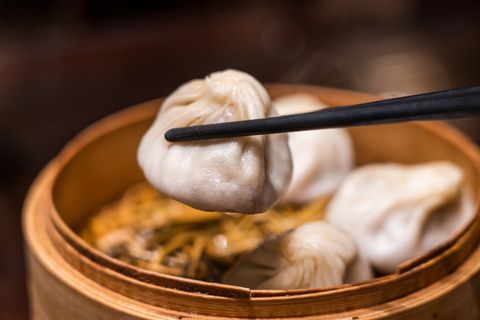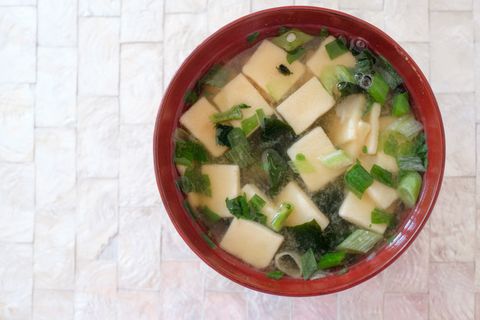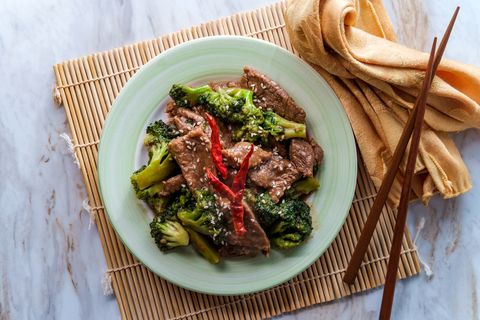If Chinese takeout is one of your go-tos on nights when you have zero energy to cook, you’ve most certainly experienced the post-meal rollercoaster of feeling super full and then weirdly kind of hungry only an hour later.
Some dishes you’ll find on Chinese restaurant menus (often modified to appeal to American meal preferences) are high in calories, but low in nutrients like protein and healthy fats, which are key for lasting satiety. That’s exactly why eating a full plate of lo mein can have you peeking into the fridge later. But not everything on the menu will leave you feeling this way. According to registered dietitians, there are many Chinese food dishes that are filling and nutrient-packed while being moderate in calories. Want to navigate the menu like a registered dietitian? Use the below list as your guide to the 15 healthiest Chinese food dishes, which includes both appetizers and entrees.
1. Steamed fish or seafood with ginger, scallions and soy sauce
One of the healthiest places you can choose an entree on a Chinese restaurant menu from is the seafood section, according to Amy Yiu, RD, a registered dietitian with Health Stand Nutrition. “Steamed fish is commonly used in many Chinese dishes,” she says, adding that most fish is high in both protein and omega-3 fatty acids. She recommends choosing a seafood dish that also comes with lots of vegetables. This will ensure your meal has adequate fiber, a key nutrient for digestive health and heart health.
More From Good Housekeeping

For a seafood or fish dish full of flavor, registered dietitian and The Mindful Chow founder Janice Chow, RD, says to look for an entree with ginger and scallions. These ingredients add flavor without added calories or sodium. It also brings extra benefits to your meal as Chow says that ginger is linked to reducing inflammation. Soy sauce is another way to add flavor to your meal, but Yiu recommends having it served on the side instead of mixed in because soy sauce can be high in sodium. Reduced sodium varieties are also available, as well as coconut aminos which are a great lower-sodium alternative to traditional soy sauce.
2. Stuffed green peppers with shrimp
Chinese stuffed green peppers, a healthy Chinese dish Chow recommends, are totally different than green peppers stuffed with beef, rice and cheese that are common in American cooking. Instead, they’re made with shrimp, fermented black beans and oyster sauce. This entree ticks many of the major nutrient boxes: protein (from the shrimp and beans), fiber (from the beans and green peppers) and carbohydrates (the beans strike again). The oyster sauce ensures every bite is full of flavor.
3. Tofu and broccoli stir fry
Most Chinese restaurants have an entire section on the menu devoted to vegetarian entrees and this is one dish that gets both dietitians’ seal of approval. If possible, Yiu says to opt for tofu that’s steamed and not fried. Fried foods — even healthy fried foods like tofu — tend to be high in trans fats, depending on the type of oil used. These types of fats are linked to cardiovascular disease and other health ailments. The broccoli in this meal supports immune health, heart health and works to keep blood sugar levels steady. Round out your meal with miso soup or a salad.
4. Chicken with green peppers
“Chicken is quite popular in Chinese dishes and white [meat] chicken is a lean protein,” Yiu says. Instead of going for a battered, deep-fried chicken entree like General Tso’s chicken, she recommends a dish where the chicken is steamed or stir fried. And again, she says to opt for an entree that comes with vegetables, such as chicken with green peppers or chicken and broccoli.
5. Chicken with garlic sauce
Sometimes a good entree really is all about the sauce. “Garlic is very good for both immune health and cardiovascular health,” Yiu says. If you do go for this entree, just be sure to round it out with a veggie-filled side to ensure you’re getting adequate fiber if it doesn’t already come with veggies mixed in. Many Chinese restaurants also use garlic sauce to spice up eggplant, so if you don’t eat meat but want to go for a garlic-forward entree, this is one menu item to consider. Add steamed tofu for protein.
6. Moo moo gai pan
Moo moo gai pan is made with lean chicken, mushrooms, snow peas, carrots and bamboo shoots. As you can see, it’s loaded with veggies. Yiu says that shiitake mushrooms are an especially beneficial ingredient because they are a good source of vitamin D, which supports immune health. Moo moo gai pan is typically flavored with oyster sauce, which is lower in sodium than soy sauce.
7. Steamed buns or dumplings
If you’re looking for a healthy appetizer or side, both dietitians recommend steamed buns or dumplings. “Jiaozi are dumplings with meat and vegetable fillings and steamed char siu bao are a Cantonese dish made with meat, peppers and a black bean sauce,” Chow says, recommending two options. Buns or dumplings made primarily with meat will add protein to your meal while veggie-filled ones bring more fiber to the table.
8. Miso soup
Yiu recommends miso soup as a healthy appetizer or side. “Miso has probiotics, which is good for gut health,” she says. Some miso soup is made with seaweed, which is full of many nutrients, including iron, calcium and vitamin K.
9. Rainbow stir fry
Rainbow stir fry is loaded with fiber-rich veggies. Yiu says that often it’s made with lentils, which are packed with protein, fiber, iron, magnesium and zinc. “Lentils are becoming more popular in Chinese food now as more people are looking for vegetarian options,” Yiu says. Some restaurants incorporate tofu in rainbow stir fry instead of lentils, which will still ensure your meal has adequate protein.
10. Beef and broccoli with garlic sauce
You don’t have to choose a vegetarian option to keep your meal healthy. Similar to chicken and broccoli, both dietitians say that beef and broccoli strikes a great protein-fiber balance. Round out your meal by mixing in a serving of brown rice.
11. Cucumber and mushroom salad
Chow recommends cucumber and mushroom salad as an appetizer for a way to start your meal off on a nutrient-rich note. That way, you’ll already know you’re getting good fiber before moving on to your entree.
12. Cucumber daikon salad
It’s also common for cucumbers to be paired with daikon (a mild-flavored white radish) as a simple salad, another healthy appetizer to consider. “The vegetables are pickled and often hemp seeds are sprinkled on top,” Yiu says. There’s no thick, sodium-loaded sauce; just simple, fresh ingredients. You’ll be hard up to find a more refreshing item on the menu.
13. Herbal soup with vegetables
The hype around bone broth may have mellowed from its 2017 peak, but it’s been used for centuries in Chinese cooking and continues to be a core ingredient. “It’s very common in Chinese cuisine to use bone broth, vegetables and lots of herbs to make soup,” Yiu says, adding that all of these ingredients are healthy. Bone broth has protein and is anti-inflammatory and the herbs used in the soup have anti-inflammatory properties as well.
14. Egg drop soup
Chow says that dishes with eggs are especially beneficial for ovo-vegetarians as a way to get protein and omega-3 fatty acids (which are important for heart and brain health). In egg drop soup, you’ll benefit from anti-inflammatory ingredients such as ginger, scallions and garlic in addition to the eggs.
15. Chinese steamed scallops and glass noodles
For a noodle-centric dish, Yiu recommends one that incorporates seafood, like this dish. The protein from the scallops will ensure your entree is more filling than just opting for noodles on their own. If the dish isn’t already made with vegetables, add a side to your meal, such as one of the cucumber salads the RDs highlighted earlier.
The bottom line
As you can see from the above list, there’s no shortage of healthy Chinese food options. The main guidelines to keep in mind if you want to make your Chinese order as healthy as possible is making sure your meal has protein, fiber, healthy fats and carbohydrates and to go light on the soy sauce, which can be full of sodium. When you put these tips into practice, you’re much more likely to be satisfied by your meal and not digging around for a snack later.
Emily is a freelance writer and certified health coach who specializes in writing about mental health, fitness, healthy food, and social justice issues. Emily spent six years as an editor and writer at Well+Good, covering everything from food trends to serious issues like the opioid crisis in America and gun violence. She has also worked at Seventeen, Elle, and Twist magazines. She regularly writes for publications including Forbes, Parade, Shape, and The Huffington Post. Emily lives in Raleigh, North Carolina with her cat Evie.







